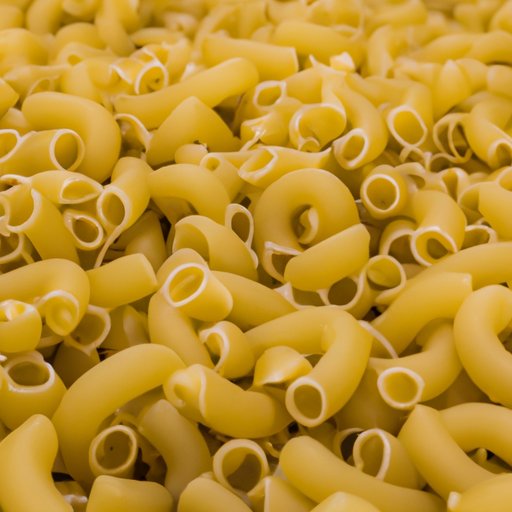
I. Introduction
The popularity of gluten-free diets has increased significantly in recent years. People with celiac disease, gluten intolerance, or wheat allergies are particularly concerned about avoiding gluten. However, many others have embraced gluten-free diets for various reasons, such as general health, weight loss, and digestive issues. Consequently, the demand for gluten-free pasta and other gluten-free products has surged. In this article, we will address the difference in taste between gluten-free pasta and traditional pasta.
II. The Science Behind Gluten-Free Pasta
Gluten is a type of protein that is mainly found in wheat, barley, and rye. Gluten provides the elasticity and chewiness of traditional pasta and other baked goods. Gluten-free pasta is made without wheat, barley, or rye, so it requires different binders to maintain its shape and texture. Some of the common substitutes for gluten in gluten-free pasta include rice flour, cornstarch, tapioca starch, and xanthan gum.
The lack of gluten in gluten-free pasta affects the cooking process and requires a few alterations to traditional cooking methods. Gluten-free pasta cooks faster than wheat-based pasta and is also more fragile and prone to sticking together.
III. Taste Comparison: Gluten-Free vs. Traditional Pasta
Before we dive into the taste differences, let’s quickly go over how to prepare both types of pasta. Gluten-free pasta requires boiling water, salt, and oil. You should not rinse gluten-free pasta with cold water after cooking, unlike traditional pasta, as this can make it mushy and difficult to handle.
To prepare traditional pasta, you need a generous amount of boiling salted water. Once cooked according to the package instructions, you should rinse the pasta with cold water to stop the cooking process.
Now, let’s evaluate the sensory experience of both types of pasta: gluten-free and traditional.
1. Appearance
Gluten-free pasta tends to be paler than traditional pasta and may appear less appetizing. It can also have a slightly different shape and texture, depending on the type of substitute used.
2. Texture
The texture of gluten-free pasta is noticeably different from traditional pasta. It is generally less chewy and more delicate. The lack of gluten also means it can fall apart if overcooked or undercooked. Gluten-free pasta can also stick together if not handled properly.
3. Flavor
As for flavor, gluten-free pasta has a slightly different taste profile than traditional pasta. Depending on the type of flour and substitute used, gluten-free pasta can taste a bit nutty or gritty. However, many brands produce gluten-free pasta that has a neutral flavor profile that is similar to traditional pasta.
IV. Factors Affecting the Taste of Gluten-Free Pasta
The flavor and texture of gluten-free pasta depend on several factors, including the quality of ingredients, type of flour used, and cooking method.
A. Quality of Ingredients
The quality of ingredients can significantly affect the taste of gluten-free pasta. Higher quality ingredients, such as organic rice flour or quinoa flour, can result in a better taste and texture.
B. Type of Flour Used
Different types of flour can also affect the taste of gluten-free pasta. For example, pasta made with a blend of rice flour and cornstarch may taste differently than pasta made with only rice flour. Experimenting with different flour blends can lead to finding the perfect combination that suits your taste buds.
C. Cooking Method
The cooking method can also impact the flavor and texture of gluten-free pasta. Overcooking can cause gluten-free pasta to become mushy and lose its texture, while undercooking can result in a gritty or chalky texture. It is also essential to avoid crowding the pot and to generously salt the cooking water to enhance the pasta’s flavor.
V. Conclusion
In conclusion, gluten-free pasta does taste different from traditional pasta due to the absence of gluten and the use of substitutes. However, with different brands and varieties available on the market, it is possible to find gluten-free pasta with a similar taste and texture to traditional pasta. By experimenting with different flours, using high-quality ingredients, and correctly cooking the pasta, it is possible to enjoy the taste of gluten-free pasta while reaping the benefits of a gluten-free diet.
VI. References
1. Cappelle, S., & Cichelli, A. (2018). Gluten-free pasta: Trends and challenges. Journal of Cereal Science, 80, 1-7.
2. Catassi, C., Elli, L., Bonaz, B., Bouma, G., Carroccio, A., Castillejo, G., … & Fasano, A. (2015). Diagnosis of Non-Celiac Gluten Sensitivity (NCGS): The Salerno Experts’ Criteria. Nutrients, 7(6), 4966-4977.
3. Thompson, T. (2010). Gluten-Free Diet: A Comprehensive Resource Guide. Regan Arts.




